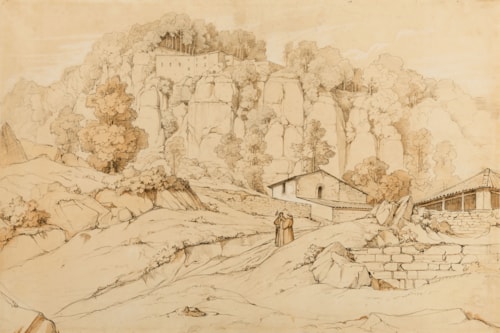
Théodore CARUELLE D'ALIGNY
Chaumes 1798 - Lyon 1871
Biography
Described by the poet, novelist and art critic Théophile Gautier as ‘the Ingres of landscape painting’, Claude-Félix-Théodore Caruelle d’Aligny enjoyed a career that lasted some fifty years, and developed a particular reputation as a painter of the paysage historique. He studied with Jean-Baptiste Regnault, Jean-Victor Bertin and Louis-Etienne Watelet before travelling to Italy in 1822, the same year that he first exhibited at the Salon, with a painting of Daphnis and Chloe. His five years in Italy, during which he met and befriended the artists Jean-Baptiste Camille Corot and François-Edouard Bertin, were vital to his career as a landscape painter. Corot was only two years older than Aligny, and the two artists spent much time together sketching in Rome and the surrounding Campagna. On their return to France – Aligny in 1827 and Corot the following year – the two friends continued to work closely together, often painting alongside each other in the forest of Fontainebleau. At the Salon of 1830 Aligny won a second-class medal at the Salon for his painting of The Persecution of the Druids under the Emperor Claudius. Both Aligny and Corot returned to Italy in 1834, with the former remaining there for about a year. (Corot came to own many drawings by Aligny, which were included in the posthumous sale of the contents of the former’s studio in 1875.)
The later 1830s found Aligny achieving some notable successes at the Salons, particularly in 1837, when two paintings of Biblical subjects were each awarded a first-class medal and another, Prometheus Chained to the Caucasus, was acquired by the State for the Musée de Luxembourg. He continued to send numerous historical landscape paintings to the Salon, and in 1842 his painting of Hercules and the Hydra earned the artist admission to the Légion d’honneur. Likewise in 1842, Aligny was commissioned by the city of Paris to decorate a chapel in the church of Saint-Paul-Saint-Louis, and the following year he received a government grant to travel to Greece to make drawings and etchings of the most celebrated sites of antiquity. This voyage resulted in the publication of a volume of his prints which became some of the artist’s best-known works. Aligny received another public commission from the city of Paris in 1858, for two landscapes of Biblical scenes for the church of Sant-Etienne-du-Mont. In 1861 he was appointed the director of the Ecole des Beaux-Arts in Lyon, where he was to spend the last decade of his career. Taken up with the responsibilities of his role as both teacher and administrator, he painted and drew relatively little before his death ten years later. A posthumous sale of paintings and drawings from the artist’s studio was held in Paris in May 1874, and the largest collections of his drawings are today in the museums of Lille and Clamecy, while a travel sketchbook is in the Louvre.


